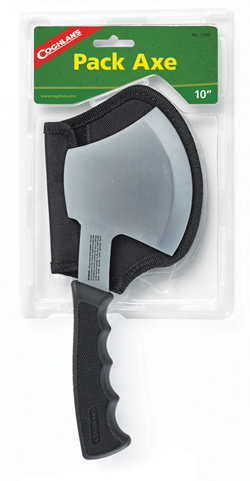The steel head of my new hatchet was pounded out old-school style by a blacksmith in Sweden. His name is Mattias Mattsson, and beside a crown insignia stamped on the axe head, Mattsson marked his creation with a signature “MM” to personalize and claim the work as his own.
Hammers and hot steel are indeed still a part of the work ethic at Gränsfors Bruks AB, a Swedish company that’s sold hatchets, axes, and other blades for more than 100 years. Mattsson is one of several blacksmiths on staff, and he and his cohorts exhibit in their products a craftsmanship rarely seen at outdoors shops today.

My Gränsfors Bruks axe, the Hand Hatchet model, is a stout chopper made for splicing tree branches and chopping wood for a fire. It has a heavy head and a short handle, weighing about a pound and a half including its leather sheath. It costs $108 and has a hickory handle that was soaked in hot linseed oil, dripped dry, and covered with beeswax before shipping off to the U.S.A.
For a comparison to the Swedish product, I decided to do a side-by-side with a hatchet of the same size from Coghlan’s. The company’s Pack Axe costs almost $100 less than the Gränsfors Bruks, and for chopping small sticks it seemed to work just about as well.
Indeed, at $17.58 on Coghlans.com, the Pack Axe is a bargain and will suit many outdoors types just fine. Like the fancy Swede, the Coghlan’s hatchet is a small and lightweight model made for camping or backpacking trips where you don’t want to haul a big blade around.
Both are about 10 inches long. The Coghlan’s hatchet has a carbon-steel head and a rubber grip. Gränsfors Bruks includes a leather sheath with rivets. It appears handmade. Coghlan’s sheath, stitched nylon with a plastic insert, has a belt clip and a Velcro seal.

In use, both stow easily in a backpack and swing a short chop to break up small wood. Unless the tree is soft, neither hatchet is big enough for logs thicker than a man’s leg.
Overall, aesthetically as well as in use, I like the Gränsfors Bruks Hand Hatchet significantly more than Coghlan’s Pack Axe. The Swedish hatchet is weighted better and feels more solid on the strike. Coghlan’s axe head is a flat stamped piece of steel that tapers slightly to an edge. The Swedish metal is thick and full of marks, stress points where Mattias Mattsson once pounded and shaped.
But aesthetics aside, Coghlan’s Pack Axe will more than do. It’s a great-priced product and a few ounces lighter than the Swedish hatchet to boot. The hatchet is essentially a solid piece of steel with a rubber handle inserted over the end. With care, it could last for years.








